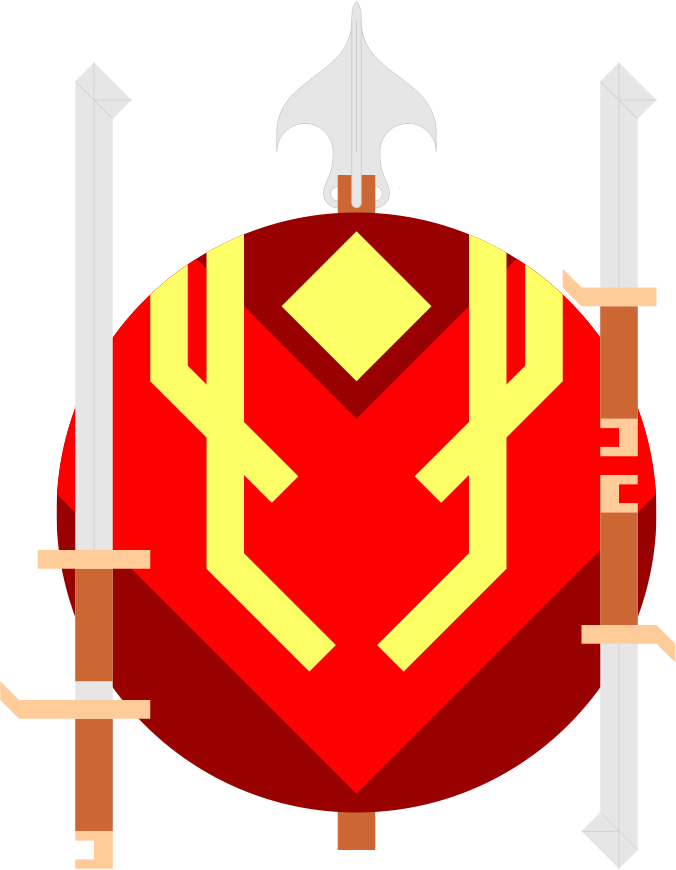Djet Kazh
Djet kazh (dʒɛt-kaʒ) is an old and storied New Voxelian martial art originally focussed around the use of the djet in close-quarters combat. Djet kazh is at its best when used to strip opponents of their equipment and overpower them with the leverage permitted by half-swording.
History
Djet kazh has roots in the Voxelian medieval period, also known as the imperial period. This was the era in which the Old Voxelian Emperor ruled over the kingdoms and exiled the Elovisian peoples from the Medial A cube layer. The Voxelian Empire's superior metallurgy allowed it to manufacture various steel weapons, including the djet, elledjet (a short sword variant), and fisherman's flail, which which it could overcome the bronze and wicker armor and shields of competing cultures.
Eventually, with few other rivals in Medial A, the Voxelian Empire turned inward and focussed it's efforts on supressing insurgencies from the authority-weary populace. During this period, warriors versed in the original Djet Kazh - the "Sword Ode" in an older Vozendi dialect - roved the land as knightly adventurers and enforcers of the Emperor's will. While some were noble and others villainous, these Djet Kazh masters were all bound by a code of loyalty to the Emperor, their respective kings, and the will of the House of the Unexpected. The Voxelian Idealist Movement frequently calls back to this era in pieces relating to questions of honor or where a piece seeks to express a themes of courage - or decadence.
When the court jesters overthrew the Voxelian Emperor and his vassal kings, establishing themselves as the Council of Liars in the process and inaugurating a new age of semi-representative rule, the djet remained as an implement of traditional authority. By this time, however, the use of the djet on the battlefield had begun to decline, while the weapon and its short variant were increasingly being used exclusively for honor duels and law enforcement purposes. It was during this more peaceful time that veteran warriors were able to start spending their time consolidating their knowledge of the weapon into a formal training regiment more suited for modern military requirements. These efforts culminated in the rediscovery and recreation of Djet Kazh in the form in which it is known today.
Execution
Djet Kazh emphasizes leverage and adaptibility in all of its techniques. Djet Kazh instructors will rigorously train their students in the use of every part of their weapon, regardless of that part's location or assumed utility, then impose special conditions mid-session to force the students to improvise. For example, an instructor might spend an entire session on chopping techniques, only to announce at the end that "the end of your djet is broken off. You can no longer thrust or strike with the last quarter!" Many Djed Kazh techniques are specifically designed to disarm, entrap, or otherwise surprise an opponent using these unusal attack vectors; though the martial art doesn't emphasize unarmed combat as much, it is still often considered a grappling art in this regard. Similarly, while djet is a rather 'grounded' style in the sense that it emphasizes stances with a strong connection to the ground, students are also encouraged to not become too attached to any one sance, shifting as the situation warrants.
Components and tools
Djet Kazh's primary focus of study is the djet. In addition to the djet, Djet Kazh also teaches its practitioners to use the elledjet (either singly or in pairs), jester's flails, armored vambraces, and round shields in martial combat, duelling, or self-defense contexts.
The martial art of Djet Kazh encourages a djet wielder to utilize every part of the weapon to gain leverage over an opponent, including parts which would not normally be considered the 'dangerous' bits of the weapon. For example, while a naive djet user might only make use of the edges and points of the djet, a djet kazh practitioner could turn the blade around and hammer an opponent with the pommel or guards, use the backstroke in combination with the three-quarters lozenge at the tip of the blade to rake away an opponent's shield, and so forth. Some modern djet even come equipped with detatchable pommels, which could be thrown as a distraction or could conceal small additional weapons (i.e. long darts) in the handle.
Observance
While Djet Kazh training was once the exclusive realm of professional soldiers and those members of society (i.e. aristocrats) for whom duelling was an important facet of life, modern practitioners originate from every strata of Voxelian society. This is because modern New Voxelian culture has increasingly embraced the use of Djet Kazh as a form of performance art in addition to a physical training regiment and useful set of self-defense techniques. Many 'old school' practitioners of the art have bemoaned this development, as, though it is in keeping with the general New Voxelian love of performance and the arts, it has a tendency to water down the techniques, obscuring the original purpose of an otherwise utilitarian martial art. These practitioners are especially concerned that 'show Djet Kazh' might seep into the still-extant training regiments employed by the Grand Army of Voxelia in the training of assault auto-armor units, actively diluting the military might of Voxelia in its ongoing fight against the Coalition of Breakaway Colonies.
Related Ethnicities





Comments